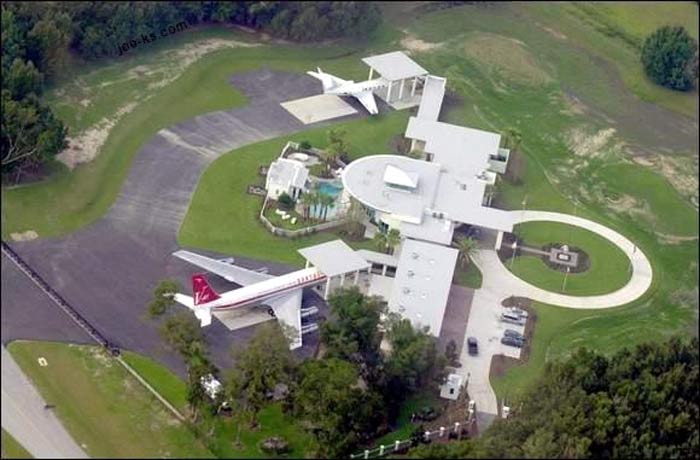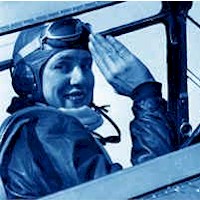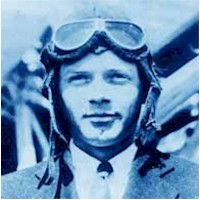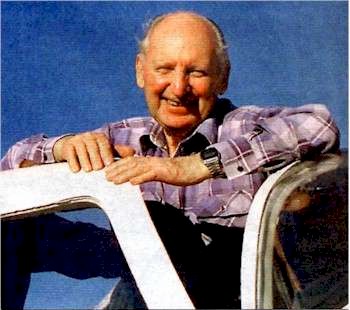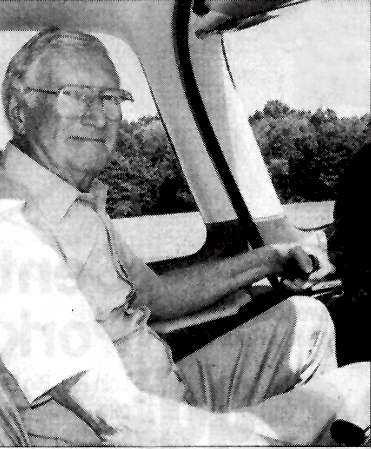A Pigeon Is My Co-Pilot
Fly-in Home of the Rich & Famous...The popular mind often pictures gigantic flying machines speeding across the Atlantic, — William Pickering, Harvard astronomer, circa 1913
Travolta's house is the ultimate boys' fantasy home made real. Aside from the parking lots for the brace of jets, Ocala, Central Florida 23 November 2004 - What do you do when your neighbours won't let you park your Boeing 707 outside your home? You move to another "housing development" - one that lets you have close-parking privileges, complete with a 1.4-mile airstrip! Following a lifelong love of aviation, 70's TV phenomenon actor John Travolta now lives in Jumbolair, just north of Ocala, Florida. Shown are two of Travolta's jets - a Gulfstream and a Boeing 707B. There aren't very many non-commercial airstrips where planes of that size can take off and land. About a decade ago, Travolta had a home in a fly-in community near Daytona, but was sued by neighbours who claimed his jet airplanes were too big and noisy for their facility. The very layout of his new house is testament to Travolta's love of flying. It's located immediately off the main airstrip, and is designed so his jets can taxi right up to two outbuildings connected to the main structure, which is shaped like a squat air-control tower. Travolta literally can walk out his door, under a canopied walkway and into the cockpit, open the long mechanised gate and be airborne in a matter of minutes. According to the Federal Aviation Administration pilot database, Travolta is qualified in several types of single and multi-engine aircraft, and has the highest pilot medical certification possible. "We know that Travolta's an accomplished pilot. A lot of people fly for the pleasure of it, and he's one of them," said John Clabes, an FAA spokesman. "If you have this many ratings on these types of high-performance aircraft, you're obviously a good pilot." In layman's terms, Travolta has enough experience flying large multi-engine jets that he could easily switch to piloting commercial airliners for a living - but why bother when you can make a hobby of it? Forty-nine-year-old Travolta flies daily from Ocala to Tampa to shoot The Punisher, an action movie based on the comic book, set to be released next summer... Tough life, but someone has to do it, eh? Source: www.joe-ks.com, www.outofrange.net via www.guardian.co.uk 16 January 2004
Gender Gap in the AirIt is now possible for a flight attendant to get a pilot pregnant. - Richard J Ferris, President, United Airlines
by Paul Payne Air crashes involving female pilots are mostly due to mishandling of the plane, while those with male pilots are more often due to flawed decision-making and inattention, a study found. Flying planes with known mechanical problems, running out of fuel and landing with the gear up were typically male problems, said the Johns Hopkins University Bloomberg School of Public Health study released last week. Women's crashes were more often due to incorrect use of the rudder, poor response to a bounce or inability to recover from a stall, the study found. "Males trade accuracy for speed," said professor Susan Baker, the study's co-author. "They would rather do something faster even if they don't do it accurately. "Women tend to be more cautious and pay greater attention to details and rules." The authors said women may have mishandled planes because they had less flight time and experience on average than men. The study in this month's issue of Aviation, Space and Environmental Medicine was prompted in part by the more than 30-fold increase in the number of female airline pilots in the United States since 1959. Officials of the US National Transportation Safety Board and the Federal Aviation Administration would not comment on the study. Hopkins scholars looked at crashes of civilian, noncommercial planes from 1983 to 1997 involving 144 female and 287 male pilots over 40 years of age. Aircraft mishandling was the most common problem for both men and women, but was blamed in 80% of female pilots' crashes and just 48% of men's. Flawed decision-making, such as misjudging weather or flying planes with mechanical defects, was responsible in about 29% of male crashes compared with 19% of women's. Inattention was a factor in 32% of male crashes but about 19% for women. Crashes are often the result of more than one error, the researchers noted. Lloyd Coleman of Beacon Flying Service said the depiction of men as hot-dogging mavericks and women as incompetent "borders on the stereotypical. You really can't say what happened in a crash because you weren't there," Coleman said. "I'm not sure how valid it is." Crashes of noncommercial, nonmilitary planes kill an average of 652 people per year, the study said. Source: The Associated Press 19 May 2001
Pilot AgePassengers prefer old Captains and young stewardesses - Great Airline Quotes Coroner Wants Age Limit for Pilots after Fatal Crash
Mr McDonald - criticised by the coroner for ignoring medical advice A coroner has called for an age restriction on pilots after three people died in a plane crash in which an 81-year-old Blenheim pilot lost control. Neville Haig McDonald crashed his Piper Cherokee in the Kirikau Valley, near Taumarunui, on 11 May 1999, killing himself and his two passengers, Heather Anne Williams, 48, and her daughter, Hayley Nicole Williams, 23, both of Tauranga. In his reserved decision, Taumarunui coroner Tim Scott said it was probable that Mr McDonald crashed after he became disoriented from the effects of a "near-fatal level of quinine", a drug he was taking for leg cramps. He was highly critical of the veteran pilot for ignoring medical advice not to fly. "At worst he appeared to be prepared to manipulate people and the system in order the retain his private pilot's licence. There was no necessity for him to take the risks that he took and they were not calculated. He risked his own life, but what is worse, he risked the lives of others, and ultimately he and others paid the price." Mr Scott said the Civil Aviation Authority should restrict pilots over the age of "70 years or something like that". A pilot's licence was a privilege, not a right, he said. Mr McDonald had ignored his doctor's advice to stop flying for a month. Mr Scott also criticised the doctor, John Hedley, for not making the ruling official. He also said Christchurch-based aviation medical assessor Graeme Scrivener failed to consider the side-effects of quinine, which include temporary blindness. What was known as the "1% rule", whereby a pilot who had a high risk of suffering a heart attack was grounded, needed to be enforced more strictly, Mr Scott said. The rule was not well followed "because of fear of pilot or medical or legal backlash". At the time of the crash, Mr McDonald was one of three pilots over the age of 80 still flying and the only one licensed to carry passengers. - NZPA Source: The Dominion Wednesday 7 March 2001; photo credit Marlborough Express Photopress
Pilot and Plane Held in High Esteem
Lloyd Huck, 79, of Morristown, in the cockpit of his Cirrus SR20, had to wait four years to get his aircraft by Jack Elliot He's flown everything from the tiny J-3 Piper Cub to the mammoth B-29 bomber. He flew about 10 different planes in the service and owned eight aircraft as a civilian. The last one was a J-3 Piper Cub based at Somerset Airport. He was in his 70s. "I didn't think I was ever going to buy another airplane," said Lloyd Huck of Morristown. But then he read a story in the AOPA Pilot magazine about a new aircraft called the Cirrus. This airplane was different. It had a fixed gear, but it could match the speed of many high-performance retractable aircraft. It was made of composite material as smooth as glass. It needed no rivets. It had no seams. That cut down on parasite drag. The control surfaces and flaps, however are metal. It cruises at 184 mph at 8,000 feet at 75% power from its six-cylinder 200-horsepower Continental engine. Huck was intrigued. He wrote to Cirrus and got information about the aircraft, the SR20. That aroused his interest even more. So he went to Florida to fly one of their 2 prototypes. "I wouldn't buy it without flying it," he said. The aircraft was different from an ordinary airplane. It had a sidestick in the armrest like military fighters and some airliners. The throttle was combined with the RPM (revolutions per minute) control reducing two controls to one. When power was reduced, the prop became a fixed pitch instead of a constant speed prop. The airplane had great visibility. Unlike most low-wing airplanes, it had doors on both sides. Also, the door not only swung open but also upward at the same time, so it wasn't necessary to squirm to get in. And it had one more thing. A parachute. Not for the passengers, but a built-in parachute for the airplane. It's like the ejection seat in a military aircraft - for use as a last resort. "There are about 200 Cirruses flying now," said Huck, "and I don't believe the parachute has ever been used." The backlog of orders for the airplane stands at 600. Production has been boosted to two a week since Huck took delivery of his airplane and they were aiming at a production rate of one a day. A second model, the SR22, has been added to the line. It boasts a 305-horsepower Continental engine and a wingspan that's 3 feet longer. It cruises at 207 mph. Huck was so impressed with the SR20's simplicity and performance when he flew it that he bought it. "I expected delivery in two years," he said. "I got it in 4 years. My wife, Dorothy, and I went out to the factory in Duluth, Minnesota, last September to pick it up. I was given 6 hours of flight training and 12 hours of ground school at the factory." His airplane is number 64. His first flight lessons were in the military in a J-3 Cub in the Army Air Corps' College Training Detachment at Oshkosh, Wisconsin, in 1943. He was then a senior at Pennsylvania State University. He was in the first group to go through the program. He worked his way up through many aircraft and wound up in a B-29. For a short time he was even a T-6 instructor. "I was getting ready to ship overseas as a B-29 pilot when the Japanese surrendered. They heard I was coming," he said, "so they gave up." After the war, he flew in the Reserves, for five years, first out of Newark, flying T-6s, and later out of Offut Field SAC Base in Omaha, Nebraska, where he flew three versions of the Twin Beech. He went back to Penn State, got his degree in 1946, and went to work for Hoffmann LaRoche as a junior research chemist and then moved into sales. When he left, after 12 years to join Merck, he was director of product development. At the time he retired 15 years ago, he had served Merck for 28 years, starting as director of marketing and working his way up to chairman of the board. His flying didn't end when he left the reserves. He checked out in a little two-place, side-by-side Taylorcraft at Westfield Airport and he took his father up for a ride. "I thought straight and level flight was boring," he recalls, "so I did a loop. My father never complained. But he never went up with me again." When he was vice president of sales and later president of Merck, Huck flew a twin Comanche on business. "Some of the other company officers weren't thrilled about that," he admits, "but I found the airplane very useful on short-range trips, like Pittsburgh, which is about 400 miles." Huck, who is now 79 - and the most youthful 79 you'll ever encounter - flew the Cirrus to Stuart, Florida, with his wife, where they spent last winter. They've also flown it to the Kentucky Derby, which took four hours, less than it would have taken them flying a commercial airline. The Cirrus is roomy and well-equipped. It has dual Garmen 430 GPS units, a 10-inch RNAV screen that can bring up a moving map, a storm scope, an engine analyser, the amount of fuel left, and the time and the distance available on the remaining fuel. The screen also can call up all of the pilot's check lists. Source: The Sunday Star-Ledger 12 August 2001 For more on the Cirrus aircraft via a review of an excellent book written by James Fallows, see also:
I hope there's a place, way up in the sky There must be a place where old pilots go, And there, through the mist, you'd spot an old guy - Captain Michael J Larkin, TWA (Retired), Air Line Pilot magazine, February 1995
Star PilotsThere are three simple rules for making a smooth landing. Unfortunately no one knows what they are. If I had a dollar for every time I heard "I always wanted to be a pilot" - Captain Jeff "The Cat" Morris Pilots Stay Cool, Save Lives, Win Honoursby Alan Levin A jet loses electrical power in darkness at 33,000 feet. A commuter plane can't maintain altitude over dangerous terrain after an explosion damages a propeller. An airliner is cleared for takeoff at a fogbound airport as another jet accidentally taxis onto the runway. Each of these flights could easily have turned tragic. But in each case, the pilots sidestepped danger, sometimes against long odds. Tonight, they will receive citations from the Air Line Pilots Association. "It's part of the pilot psyche and culture to say this is really no big deal. But if you look at what these crews were suddenly facing and to have outcomes this good, it's a lot more than a normal job," says John Cox, safety chairman for the Air Line Pilots Assocaition (ALPA), a pilots union. The award winners share several traits: teamwork, good training and ingenuity under pressure. Aviation safety experts constantly preach these values as the best way to avoid accidents. Among the pilot award winners at this year's ALPA Air Safety Forum:
Other award winners include Captain Ken Adams of Delta Air Lines, a longtime ALPA accident investigator, and Captain C E Rowe and co-pilot R J Porkolab of Alaska Airlines, who fought off a man who broke into the cockpit in March 2000. Source: USA Today Wednesday 15 August 2001
"Sorry Guys, We're Dead"I read a newspaper article in early 1997 about two Black Hawk helicopters which collided in mid-air last year in Australia during a routine training exercise. The lead helicopter turned right unexpectedly and his rotor cut the tail off the helicopter behind him and punctured its fuel tank. The offending helicopter, without a rotor, plunged to earth in a fiery ball and everyone on board was killed. The helicopter minus its tail had a couple of minutes of manœuvering time before it ran out of fuel. The men on board the second craft saw all their buddies in the lead helicopter die. The pilot of the second machine, a guy named David Burke, struggled to keep his helicopter upright. He said his instructor had told him that if you could land it on its wheels, you had a chance to survive. The helicopter spun around three times and started pitching. The pilot thought the craft had turned completely upside down. "Sorry guys, we're dead," he said to his fellow crewmen just before they slammed into the ground. But he DID land it on its wheels, and 12 of the 15 men on board survived - including David Burke.
To view other articles related to flying including history, unusual flying machines, hot air balloons, skydiving, gliding, problems, airports, turbulence, pilots, crashes, the
Paris Air Show, the future, blimps, space travel, solar sails and more, clicking the "Up" button below takes you to the Table of Contents for this section on Flight. |
 Animals
Animals Animation
Animation Art of Playing Cards
Art of Playing Cards Drugs
Drugs Education
Education Environment
Environment Flying
Flying History
History Humour
Humour Immigration
Immigration Info/Tech
Info/Tech Intellectual/Entertaining
Intellectual/Entertaining Lifestyles
Lifestyles Men
Men Money/Politics/Law
Money/Politics/Law New Jersey
New Jersey Odds and Oddities
Odds and Oddities Older & Under
Older & Under Photography
Photography Prisons
Prisons Relationships
Relationships Science
Science Social/Cultural
Social/Cultural Terrorism
Terrorism Wellington
Wellington Working
Working Zero Return Investment
Zero Return Investment